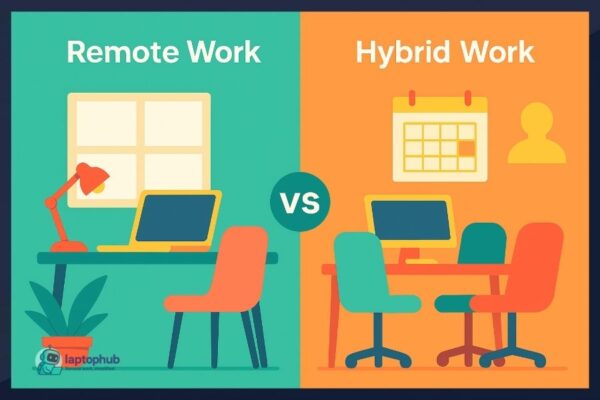The Future of Remote Work: 10+ Trends to Watch in 2025 and Beyond
Remote work has transitioned from a temporary solution to a permanent fixture in the modern workplace. As of late 2024, Gallup reports that 55% of U.S. employees with remote-capable jobs are working in hybrid arrangements, while 26% are fully remote. This shift underscores a broader transformation in how organizations operate and how employees engage with their work.
Whether you’re a business leader, HR professional, or remote worker, staying informed about emerging trends is crucial. Here’s what to watch in the evolving landscape of remote work.
💡Key takeaways:
- Remote work is shifting toward hybrid and asynchronous models that prioritize flexibility and autonomy.
- AI tools and new communication platforms are reshaping productivity and collaboration across distributed teams.
- Legal frameworks, cybersecurity, and remote work policies are rapidly evolving to support global compliance and employee well-being.
- Sustainability, compensation structures, and industry-specific adoption show that remote work is not one-size-fits-all but deeply strategic.
1. Hybrid Work Becomes the Norm
McKinsey’s research shows that 56% of employees are working in hybrid models, typically attending the office 1–4 days per week.
Why it matters:
- Hybrid attracts and retains talent.
- It optimizes real estate and workplace costs.
- Employees benefit from improved flexibility.
2. Work-from-Anywhere Policies Expand
According to Gallup, 61% of on-site workers with remote-capable jobs would prefer hybrid work, and another 28% prefer to be fully remote.
Challenges:
- Navigating international tax and labor laws
- Managing team collaboration across time zones
- Ensuring cybersecurity and data protection
3. Asynchronous Communication Gains Importance
Async communication lets distributed teams collaborate effectively without being online at the same time. It supports focus, reduces Zoom fatigue, and allows for global productivity.
Popular tools: Loom, Notion, Twist, and Slack Threads.
4. AI Integration Enhances Remote Collaboration
AI is reshaping how remote teams work. From automating meeting notes to smart task tracking, AI cuts down busywork.
Popular tools include:
- Otter.ai and Fireflies for meeting transcriptions
- Notion AI for document generation
- ClickUp AI for task automation
- ChatGPT for ideation and content support
5. Emphasis on Digital Well-being
According to Gallup’s global workplace report, 41% of employees experienced high stress the previous day—remote work burnout is very real.
Best practices:
- Set clear work-life boundaries
- Introduce no-meeting days
- Offer virtual therapy and mental wellness stipends
6. Evolution of Compensation and Hiring Practices
Remote work has changed how companies approach hiring and pay:
- Location-based pay adjustments
- Global hiring platforms like Deel and Remote.com
- Growing push for transparent, equitable salaries
7. Heightened Focus on Cybersecurity
Cybersecurity remains critical in a distributed environment.
Strategies include:
- VPN and endpoint security enforcement
- Zero-trust network models
- Mandatory cybersecurity training
8. Emergence of Virtual Workspaces
While the metaverse hasn’t gone mainstream yet, virtual environments like Gather, Spatial, and Meta Horizon are being used for onboarding, training, and virtual collaboration.
9. Formalization of Remote Work Policies
Companies are no longer improvising—they’re investing in structured policies. GitLab’s remote playbook is a prime example of a transparent, detailed policy framework.
Common elements:
- Equipment and home office stipends
- Clear availability expectations
- Onboarding and documentation procedures
10. Legislation Is Catching Up With the Remote Era
Several governments are updating labor laws to reflect a remote-first world:
- Portugal prohibits employers from contacting workers outside office hours
- Canadian and EU laws are pushing “right to disconnect” rules
- U.S. states like California are defining clearer tax obligations for remote workers
11. Remote Work’s Role in Sustainability
A Global Workplace Analytics study showed that if those with remote-compatible jobs worked from home half the time, the reduction in emissions would equal taking 10 million cars off the road annually.
Green benefits of remote work:
- Lower commuter emissions
- Reduced office energy consumption
- Fewer business travel-related flights
12. Remote Work Becomes Industry-Specific
Each industry is adapting to remote work differently:
| Industry | Example Use Case |
|---|---|
| Tech | Fully remote dev teams |
| Healthcare | Growth in telehealth services |
| Education | Online courses and LMS platforms |
| Marketing | Remote creative agencies |
| Finance | Hybrid roles, digital audits |
| Legal | Virtual consultations, court e-filings |
Future of Remote Work FAQs
1. What is the future of remote work in 2025?
The future of remote work includes a rise in hybrid models, asynchronous collaboration, global hiring, and AI-powered tools, all supported by evolving legal frameworks and better remote work policies.
2. Will companies continue remote work long-term?
Yes, many companies are adopting remote and hybrid models as a permanent part of their operations due to increased productivity, cost savings, and talent access.
3. How is AI affecting remote work?
AI is streamlining communication, automating administrative tasks, summarizing meetings, and helping remote teams manage projects more efficiently.
4. What are the challenges of remote work?
Major challenges include maintaining cybersecurity, managing global compliance, preventing burnout, and ensuring clear communication across time zones.
5. Which industries benefit most from remote work?
Tech, marketing, education, healthcare (via telehealth), and some legal and finance roles are well-suited for remote or hybrid models.
Final thoughts: The Remote Work Evolution Is Just Beginning
Remote work has gone from novelty to necessity. In 2025 and beyond, it’s about doing it better:
- Investing in tools and training
- Building async-friendly cultures
- Securing teams and data
- Staying legally compliant
- Supporting employee health
📌 Pro tip: Treat remote strategy as a core business function—not a temporary perk.





